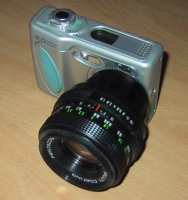Notes on the IR conversion of handheld Digital Cameras.
Safety First
If the camera you want to convert has a flash then there is a risk of electrocution!
Camera flashes operate at a high voltage (several hundred volts) which could in theory deliver a fatal electric shock. To make matters worse, the high voltage is still present when the camera is switched off, and even when the batteries are removed. If you still want to continue, be very careful. The capacitor that stores the charge for the flash is usually a large cylindrical object. Avoid touching the connections on this and any part of the circuitry that may be connected to them. It is not usually easy to identify what bits of circuitry are connected to the flash so it's better not to touch anything electrical in there.
High Density
Webcams are very simple devices, usually containing just one circuit board and not much else. Handheld digital cameras are totally different. Opening a digital camera can easily be the end of it's life. They often contain small parts that are only held in place by the camera's case. Getting the case open may not be as simple as it looks either, some plastic cases are held together with clips designed not to be undone. The only real advice I can give for this is don't try this on your top of the range £500 camera. I have converted cheap cameras from eBay but wouldn't dare open my Canon IXUS.
Focus
The webcam page deals with cameras of a very simple design where the focus adjustment doubles as the lens attachment. I haven't seen a handheld camera with anything quite that simple. I've never seen a manual focus compact digital camera at all. This makes things tricky as removing a significant thickness of glass (the IR Filter) from the system changes the focus completely. On the cheaper handheld cameras the lens is fixed and focussing is not possible. These are probably the best to modify as the lens system is very similar to the webcam design but the focus can't be moved because the thread is glued in place. I have found that this can unsually be unglued by squeezing the plastic with pliers from various directions, and cracking the glue. You can then continue as with the instructions on the webcam site.
Variable focus cameras are not recommended at all for the modification. The mechanics to move the lens are very delicate and carefully set up by the manufacturer. If you really do want to modify one of these then (you're mad) you can try to replace the filter with a similar thickness of plain glass. Finding the correct thicknes would be important and getting the thing back together cleanly would be next to impossible.
Cheating
Sorry if this goes over the heads of any non-SLR photographers.
If you don't mind what the camera looks like there is a method of converting some cameras that makes the job easier and allows you to play with the camera in other ways. This method involves removing the original lens and replacing it with the lens from a standard SLR camera. This will give you manual focus control and will allow you to use any filter you like. There's another aspect to this that can be considered good or bad depending on your point of view, a standard 50mm SLR lens gives about 10X magnification. I modified a camera in this way some time ago and found it very easy. Below is the original camera.

I cut around the lens window in the front of the camera casing with a small drill. Then I unscrewed the main lens assembly below after cracking the glue as mentioned earlier. This left me with a camera with a huge gaping hole in the front. I glued an SLR extension tube (shown below) to the front of the camera which gave me a standard M42 lens mount to screw lenses into. The length of the tube is important as it must hold the lens approximately the right distance from the sensor. This distance must be a standard as the lenses are interchangeable but I don't know what it should be. I just measured the distance from the front of an SLR camera to where the film sits inside it.

The original camera, the extension tube and the lens cost less than £10 in total from eBay together they look like this.

It doesn't look pretty but with this camera I can also add further extension tubes to allow extreme closeup work or swap the lens for a bigger one (I have a 400MM one from eBay) to do long range photography. For any long range work you'll need a tripod, holding a camera still enough is not humanly possible.
That just about sums up my knowlege of handhelp IR modded digital cameras. I guess it wouldn't quite fit on the back of a postage stamp - but with a small enough font, perhapse an envlope.
I hope some of this has been useful or at least interesting, thanks for reading.



